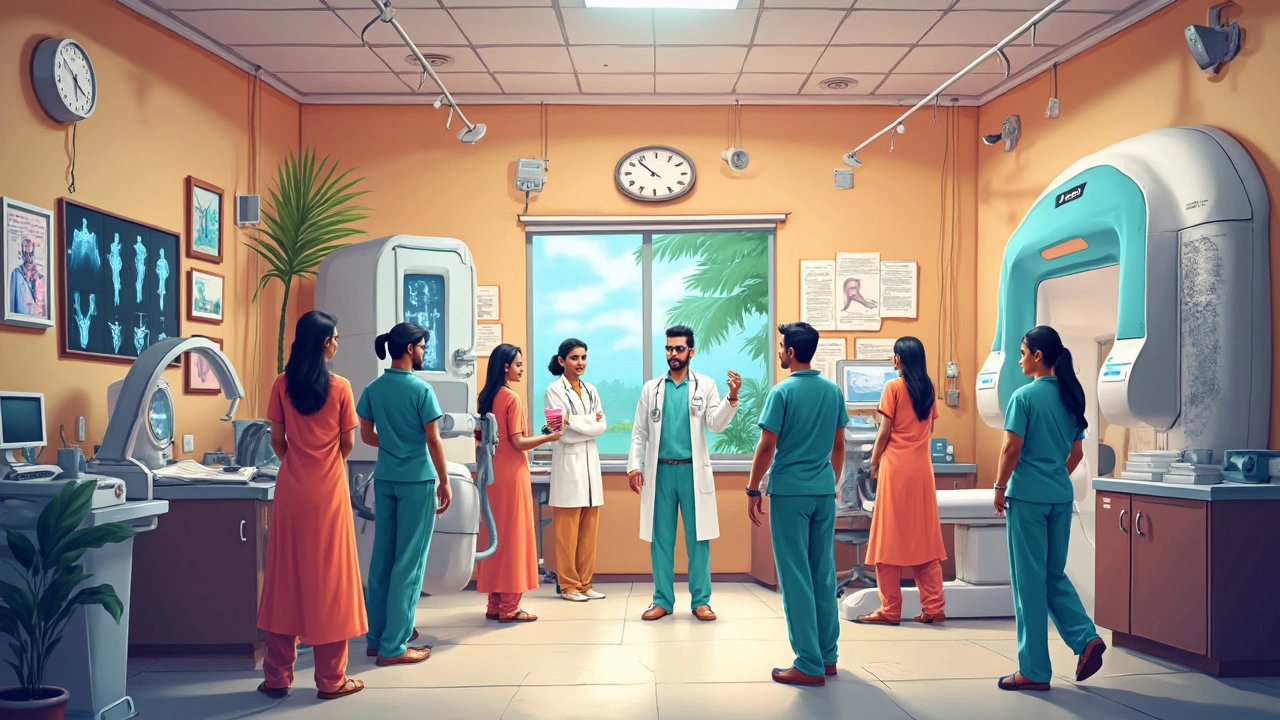Ever wondered which test is best for checking out bones and joints? It's one of those things you might not think about until something starts creaking or aching. But, getting the right test can make all the difference in understanding what's really going on inside.
Let's start with why these tests are so crucial. Your bones and joints are like your body's frame and hinges. If something's wrong, it can throw everything off. That's where our trusty X-rays come in. They've been around for ages, giving a straightforward glimpse into the bony bits. But sometimes, you need more info, like when you can't quite figure out why your knee's been acting up, and that's when MRIs or bone scans might step in.
So, if you're booked for one of these tests or curious about what they might unveil, keep reading. We'll dive into how each test works, what it reveals, and some handy tips for making the whole process smoother. Whether you're just being proactive or dealing with a nagging issue, understanding these tools is a solid first step.
- Understanding the Basics: Why Tests Matter
- X-Rays: The Classic Choice
- MRIs: Peering into the Details
- Bone Scans: Detecting the Invisible
- CT Scans: A Comprehensive Look
- Choosing the Right Test: What to Ask Your Doctor
Understanding the Basics: Why Tests Matter
Alright, let's get real about why testing for bone and joint health is super important. Think about your body as a machine. Any odd noise or malfunction gets you reaching for the toolset, right? Your bones and joints work the same way—they're foundational. If they falter, it’s tough for the rest of your body to soldier on.
One major reason these tests matter is accuracy. Yeah, some of us like to think 'I can just walk it off,' but without proper insight, even minor problems can spiral. These tests are like a window into what's happening beneath your skin.
For instance, an old-school X-ray might show if you've got a fracture, but if the picture seems fuzzier, like pain without apparent reason, doctors might suggest an MRI. Why? Because MRIs capture tissue detail that X-rays can't.
| Test Type | Primary Focus |
|---|---|
| X-ray | Fractures, bone structure |
| MRI | Soft tissue, joint issues |
| CT Scan | Complex fractures, cross-sectional images |
| Bone Scan | Bone metabolism, infections |
Another biggie is early detection. This is crucial. Catching an issue in its early stages can save you heaps of trouble (and sometimes surgery) down the road. For those managing chronic ailments like arthritis, regular testing helps track disease progress and adjust treatments accordingly.
And let's not forget peace of mind. Tests often lay those nagging worries to rest. Knowing exactly what's going on allows you to face any issue head-on, informed and prepared. So if your doctor recommends a test, it's not just routine—it's a step towards keeping your body’s framework sturdy and trouble-free.
X-Rays: The Classic Choice
Alright, let's talk about X-rays, the old faithful of bone tests. They've been the go-to method for checking bone health ever since Wilhelm Roentgen first discovered them in 1895. It's like peeking inside your body without any invasive procedures. X-rays are super useful because they're quick, easy, and relatively cheap.
So, how does it work? An X-ray machine uses a small amount of radiation to capture images of bones. These images are black and white, with bones appearing white and softer tissues showing up in shades of gray.
Why are X-rays so popular for looking at joints and bones? They're perfect for spotting fractures, dislocations, infections, and even some tumors. Got a nagging ankle pain or suspect a broken wrist? An X-ray might be the first step to figuring it out.
You might wonder about safety concerns because of the radiation. But don't stress too much. The amount of radiation from a single X-ray is low. It's like spending a few extra days in the sun. However, it's always good to mention any health issues you have or if you’re pregnant, so the doctors can take extra precautions.
Here's a quick breakdown of the pros and cons:
- Pros: Fast, non-invasive, affordable.
- Cons: Doesn't show soft tissues well; involves small radiation exposure.
So, if you find yourself needing a bone check, X-rays might just be your best buddy. They're reliable and straightforward, keeping it simple when your body needs a good look.
MRIs: Peering into the Details
When it comes to figuring out what's going on inside your bones and joints, MRIs are like superheroes of the medical world. Short for Magnetic Resonance Imaging, this technology lets doctors see the inside of your body in great detail, way beyond what X-rays can offer. They're super helpful for spotting issues in the soft tissues like muscles, tendons, and even the cartilage, which aren't visible on X-rays.
So how does it work? Well, an MRI uses a strong magnet and radio waves to create detailed images of your body's insides. If you’re hearing 'magnet' and thinking of fridge magnets, imagine something way more powerful! You'll find MRIs especially useful for checking out ligaments or suspected tears in areas like the knee or shoulder. They’re also great for diagnosing things like joint inflammation or detecting a bone fracture that just doesn’t show up elsewhere.
And here’s a tip: When you’re going for an MRI, you’ll need to stay super still while the machine does its thing. Climbing in for a scan might take a bit of patience—sounds can be pretty loud, so many places offer earplugs to keep you comfy. Don’t worry, though; the whole process is completely painless.
Now, a bit of handy advice if you're considering an MRI: always check with your insurance if it’s covered. They're often pricier than other tests, so keeping that in mind can save you a surprise bill. Plus, it’s always smart to talk with your doctor about whether an MRI makes sense for your situation. Sometimes, a less detailed test could do just fine without the extra cost.
| Type of Scan | Details |
|---|---|
| X-Ray | Good for bones, not soft tissue |
| MRI | Great for soft tissue, pricier |
| CT Scan | 3D images, less detail than MRI for soft tissue |
In a nutshell, MRIs are all about detail. They're not always the first stop on the medical testing train, but when they’re needed, they’re a total game-changer for getting to the root of what’s going on with your bones and joints.

Bone Scans: Detecting the Invisible
So, you're curious about bone scans, huh? These nifty tests are like the undercover agents of the medical world. They're there to spot issues that might be sneaking around unnoticed by other tests. Unlike the straightforward snapshot of an X-ray, bone scans work by checking out the activity inside your bones.
Here's how it goes down: you'll get a small amount of radioactive material injected into your vein. Don't worry; it's not as scary as it sounds. This stuff makes its way to your bones, and after a couple of hours, a special camera snaps images that highlight areas of unusual activity. Think of it like using a flashlight to find stuff in the dark.
Now, why would you need a bone scan? They're pretty handy for spotting infections, hidden fractures, or even conditions like arthritis and cancer. They're especially useful when you have persistent pain, but other tests haven’t shown the whole picture.
Check this out:
| Feature | Bone Scan Insights |
|---|---|
| Common Uses | Detecting infections, fractures, and tumors |
| Procedure Time | 2-4 hours including wait time |
| Radiation Exposure | Low—comparable to X-rays |
Unlike other joint tests, bone scans excel in areas where bone metabolism is a concern. That's why doctors might suggest one if an injury isn't healing as expected, or if there's unexplained swelling. When you're prepping for a bone scan, you'll be advised to stay hydrated and remove metal jewelry that could interfere with the images.
One last tip: jot down any questions you have beforehand. It can be comforting to have a chat with your doc before jumping into unknown medical territory. That way, when you walk out, you'll have a clearer idea of what those bones and joints are trying to tell you.
CT Scans: A Comprehensive Look
So, you’ve probably heard about CT scans before, but what makes them such a big deal in the world of bones and joints? Let's unravel it. CT stands for computed tomography, and it’s like X-rays but on steroids. A CT scan gives you a 360-degree view, creating detailed cross-sectional images of your insides. It’s super handy for getting a look at complex fractures or checking out the alignment of bones.
Picture this: you're looking to confirm whether a tiny fracture you can't see with a regular X-ray is there. A CT scan can be your go-to without a hitch. It's detailed enough to show not just the bones but also some soft tissues, which is pretty awesome if there's swelling you’re concerned about.
CT scans shine when there's a need to assess the damage from an accident or if you're considering surgery and need to plan meticulously. It's also great if there's a suspected bone tumor or an unusual growth. Doctors can use the detailed images to decide on the best course of action, whether it’s surgery or another treatment.
Now, what about the process itself? It’s pretty straightforward. You're asked to lie down on a table that slides into a big, doughnut-shaped machine. The procedure takes about 10 minutes, and while it's happening, you need to hold still—it helps keep images sharp. Usually, there’s no prep needed unless they've told you otherwise, like maybe fasting for a bit.
There’s a bit of radiation involved with CT scans, more than an X-ray, but it’s typically well within safe limits. Of course, your doc will weigh the risks and benefits before opting for one. If you’re ever unsure or apprehensive, it’s always cool to chat with them about it until you feel comfortable.
Choosing the Right Test: What to Ask Your Doctor
Picking the right test to check out your bone or joint issue can seem overwhelming, but it doesn't have to be. It's all about asking the right questions and understanding what each test can offer.
First off, chat with your doctor about why they're recommending a specific test. Is it because they're looking for a certain kind of problem? Like, if they suspect a fracture or arthritis, an X-ray might do the trick. But if they're pondering what's happening with the tissues or ligaments, an MRI could be the go-to.
Here are a few questions to help you get started:
- What specifically are you looking for with this test?
- How does it compare to other options like MRIs or CT scans?
- What are the risks or downsides I should know about, like radiation in the case of X-rays or CT scans?
- How should I prepare for the test? Is there anything special I need to do beforehand?
- How soon will we get the results, and what will the next steps be after we have them?
It’s also important to consider your own comfort and convenience. For example, some folks find MRIs a bit claustrophobic, so if that's a concern, let your doctor know. They might have alternatives or suggestions for making you more comfortable during the process.
Understanding these tests and having open conversations with your healthcare provider ensures that you're not just a passive patient but an active participant in your health journey. It's all about ensuring you get the most accurate diagnosis with the right approach.
